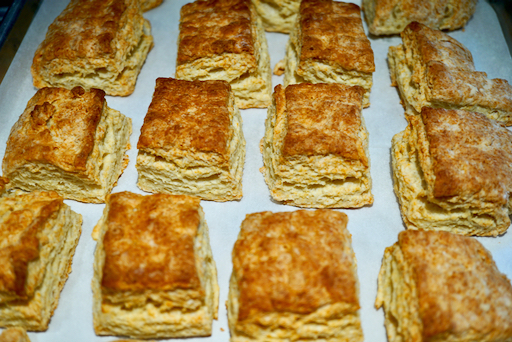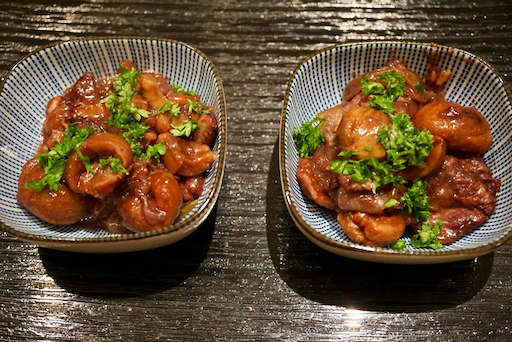A few weeks ago, my wife suggested that it has been quite a while since we had sukiyaki すき焼き and it would be nice to have some. I agreed, but when I went to the Japanese grocery store, I forgot to get the frozen "Sukiyaki meat" すき焼肉. So, the next time I went I was proud of myself for not forgetting the meat. But apparently I picked up the wrong thing. My first clue was when my wife said, “I didn’t know sukiyaki is made with pork, I thought it was beef.” Instead of sukiyaki beef, in my haste I had picked up thinly sliced pork for "shouga-yaki" 生姜焼き. Since this package was next to the "shabu-shabu" シャブシャブ beef, I assumed it was also beef but for sukiyaki. In my enthusiasm I bought not one but two packages of the stuff. All was not lost, however, as I may have mentioned before, in Hokkaido 北海道, where I am originally from, many families use pork instead of beef for sukiyaki as was the case in my family. So, we went ahead and used one of the packs of pork to make sukiyaki. It was not good. The pork was too lean and too thickly cut. It got hard when cooked as sukiyaki. (So note to self: next time when at the Japanese grocery store get appropriate sukiyaki beef). Meanwhile, since I had bought two packages of this pork, I had one package left and it was clear that it would not be used for sukiyaki. So, one weekend I decided to use the pork as originally intended and made “shoga-yaki” ginger pork. Pork shoga-yaki 豚の生姜焼き is a very popular dish in Japan. When I was a college student, coffee shops near the university served lunch in addition to tea and coffee. In addition to “Western-style” lunches such as sandwiches or spaghetti, most of the coffee shops also served Japanese-style bento 弁当 or teishoku 定食* and shoga-yaki was among the popular ones. I am sure this has not been changed even now.
*Digression alert: I am sure it is no need to explain “bento” but here it goes anyway. When “bento” is served in restaurant/coffee shop, it is usually a lidded rectangular box which contains the entire meal but unlike pre-packaged bento, the rice and dishes are warm or just made. "Teishuku" (please follow the link for illustrated guide) is the Japanese concept of a "complete" meal or "meal set" which includes a bowl of rice, soup, tsukemono 漬け物 (pickled or more likely salted vegetables), main dish (protein) and small "kobachi" 小鉢 side dish or bowl. In many "Taishu-shokudo" 大衆食堂 or "public" eateries which serve those who want drinks with food and those who want a complete meal, many different teishoku are available (the main protein dish varies and can be grilled fish, sashimi, or meat etc) but the remaining items, or “sides” such as soup, tuskemono, are usually the same for each available teishoku. The main and side dishes can be had as a single dish without other items (this is great especially if you are just drinking). It could also be "teishoku" for the price of a few more yen.
So, this is my rendition of "shoga-yaki" donburi teishoku 生姜焼き丼定食. In this case, the main protein and rice were combined as a donburi.
The main dish shown in the next picture is a bed of rice to which I added pork shouga-yaki with onion, seasoned shiitake mushroom (this was from dried shiitake and seasoned in "ama-kara" 甘辛 or sweet and salty with mirin and soy sauce) and blanched broccoli.
Miso soup is wakame ワカメ sea weed, "abura-age" 油揚げ fried tofu, silken tofu 絹ごし豆腐 and chopped scallion ネギ.
The tsukemono is cucumber, daikon, nappa cabbage, jalapeño pepper, and ginger (I salted this a bit stronger than I usually do; with salt 3% of the weight of the veggies instead of usual 2% and also added a dash of Vodka which makes it last much longer without changing the taste. (With this preparation it can easily last for at least one week in the refrigerator).
How to make pork shouga-yaki ginger pork (Although I posted "
shouga-yaki" over 11 years ago, this time, I am using a more appropriate, albeit not perfect, cut of meat). I am sure that there are so many variations and preferences and, of course, you could use other meat such as beef but this is what I made.
The essence of this dish is thinly sliced meat sautéed and seasoned sweet soy sauce flavored with ginger. Using lean meat can make tough shouga-yaki and using fatty cuts such as thinly sliced pork belly will prevent that but the traditional cut to be used is "pork roast" meat 豚のロース cut thinly (thin enough but not paper thin).
Ingredients:
Thinly sliced pork, 4-5 slices for one meal size serving (in Japan, specially packaged "shouga-yaki" pork is available widely. The one I got here is a bit too lean, the perfect cut has more fat. I used the entire package which is about 20 slices).
2-3 tsp neutral oil
Onion slices, optional
For marinade:
Mirin, soy sauce, and sake (1:1:1) ratio, enough to marinate the meat plus more to add while cooking.
Grated ginger (amount arbitrary, totally depends on your taste, I used whole grated ginger but you can use just the juice from grated ginger).
Dash of dark sesame oil
(optionally, grated onion).
Directions:
Marinate the meat. The amount of the marinade is enough to cover all meat slices and a bit more (additional 1/4 cup). I marinaded for 1 hour in the refrigerator.
I drained the marinade (the excess marinade reserved) and spread the meat slices on a paper towel to remove excess marinade.
In the non-stick frying pan, add 2 tsp neutral oil on medium flame.
Add onion slices and cook until soft and somewhat transparent, set aside
Cook the meat slices, spread out without over lapping, in batches. One side 30 seconds and the other side 15 seconds. Do not overcook (the meat will finish cooking when cooked with the marinade later).
Set aside the cooked meat slices.
When all the slices are cooked, add the marinade to the pan (if not enough add more sake, mirin and soy sauce).
Add back the cooked meat with the accumulated juice and the onion .
Quickly cook and coat each slice with the marinade. Take it out and set aside.
Since I was planning to make a doumburi, I added a small amount of water at the end and heated the marinade to make sauce.
Assembly:
Top the rice with the shouga-yaki pork slices (I used 3 slices per bowl).
Pour in the sauce from the frying pan (just slightly moisten and season the rice).
Add any other garnish or topping (such as ginger julienne in vinegar or "benishouga" 紅生姜). I added seasoned shiitake mushrooms and blanched broccoli.
Compared to the sukiyaki we made with this pork, the shouga-yaki came out much better. The meat was tender and well seasoned. Perfect lunch for the weekend.






















































